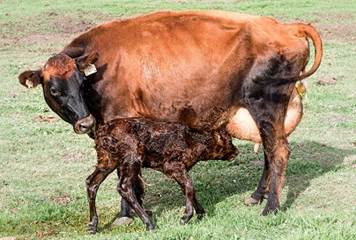 CDCB Connection June 2017
CDCB Connection June 2017
Coming in August: Gestation Length Evaluations

Starting in August 2017, dairy producers will be able to utilize U.S. genetic evaluations for gestation length when selecting sires. The new trait, gestation length for service sires, is available thanks to the efforts of Jan Wright and Paul VanRaden of USDA's Animal Genomic and Improvement Laboratory (AGIL). The launch of gestation length follows the introduction of cow livability by CDCB last August and demonstrates the accelerating trend for evaluations on more traits.
Once bull evaluations were readily available for milk and fat yields, it took over 50 years before evaluations for the next traits, protein and type. Then it was another 16 years before evaluations for somatic cell score and productive life became available. Now, it is likely genetic evaluations for one or more new traits will be introduced each year. There's more good news: In this genomic era, accuracies (reliabilities) of the evaluations for new traits are markedly higher than those published prior to 2008. In addition, genomic testing improves predictions for all traits introduced earlier.
Why have dairy breeders and semen marketers asked for genetic evaluations for gestation length? They believe having predicted gestation lengths on service sires can help keep parturitions concentrated in herds with seasonal calving. This information will also help to pinpoint expected calving dates and to aid maternity management in all operations. Gestation length may also be adopted as a correlated trait to improve calving ease.
It is expected that a primary use of the new gestation length will be to choose service sires for cows that didn't conceive on their first service in seasonal calving herds. There are no current plans to incorporate gestation length into CDCB's Lifetime Net Merit indices. Previous research by Norman et al.1 showed that cows having intermediate gestation lengths were the ones with the most favorable same-lactation or subsequent performance for several other economically-important traits. The traits examined included calving ease, stillbirth, the current and subsequent lactation milk and milk component yields, and longevity.
As this new trait becomes available, it is suggested that producers continue to rely primarily on a composite economic index like Lifetime Net Merit, Cheese Merit, Fluid Merit or Grazing Merit. The choice of an index should depend on a farm's milk payment situation and their management system. Nevertheless, producers with a seasonal calving operation might consider bypassing those service sires with long predictions for gestation length, as a means of keeping calving frequencies in sync with their nutritional supplies.
Article prepared by Duane Norman, Technical Advisor & Industry Liaison, Council on Dairy Cattle Breeding (CDCB)
1Norman, H.D., J.R. Wright, and R.H. Miller. 2011. Potential consequences of selection to change gestation length on performance of Holstein cows. J. Dairy Sci. 94 (2):1005-1010.
Animal Genomic and Improvement Laboratory (AGIL) is part of Agricultural Research Service (ARS) of the United States Department of Agriculture (USDA)